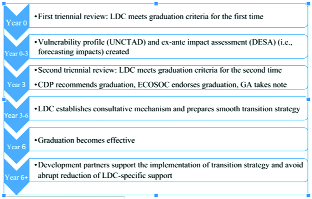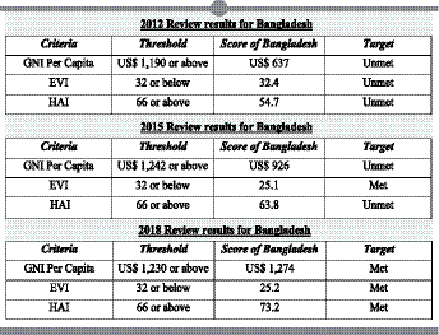The concept of creating a separate group termed Least Developed Countries (LDCs) originated in the mid-1960s with a view to providing special attention and supports to the "less developed" of the developing countries. As a result, in the very first meeting of the UNCTAD (UN Conference on Trade and Development) held in 1964, the global community agreed that special attention would be "paid to the less developed among the developing countries, as an effective means of ensuring sustained growth with equitable opportunity for each developing country".
Thereafter, through comprehensive examinations of the situations of the "less developed" countries, three criteria for LDC classification were determined. The criteria were (i) per capita of GDP US$100 or less; (ii) share of manufacturing in total GDP of 10 per cent or less; and (iii) adult literacy rate of 20 per cent or less. On the basis of the mentioned criteria, initially 25 countries were listed as LDCs by the UN through its resolution 2768 (XXVI) of November 18 1971. Subsequently, many other countries were included in the list. Bangladesh was also included in the LDC list in 1975. Currently, the number of LDCs in the world is 47.
The Committee for Development Policy (CDP), a subsidiary body of the UN Economic and Social Council (ECOSOC), is mandated to review the category of LDCs in every three years and monitor their progress after graduation from the category. The LDC criteria for both inclusion and graduation had also been reviewed and changed from time to time.
Current LDC criteria for inclusion and graduation: The inclusion of LDCs is currently based on three criteria: (i) Per capita Gross National Income (GNI), (ii) Human assets and (iii) Economic vulnerability to external shocks. The latter two are measured by two indices of structural impediments, namely the Human Assets Index (HAI) and the Economic Vulnerability Index (EVI).
Human Assets Index (HAI) is calculated on the basis of indicators of: (a) nutrition: percentage of population undernourished; (b) health: mortality rate for children aged five years or under; (c) education: the gross secondary school enrolment ratio; and (d) adult literacy rate. Economic Vulnerability Index (EVI), on the other hand, is calculated on the basis of indicators of: (a) population size; (b) remoteness; (c) merchandise export concentration; (d) share of agriculture, forestry and fisheries; (e) share of population in low elevated coastal zones; (f) instability of exports of goods and services; (g) victims of natural disasters; and (h) instability of agricultural production.
It may be noted here that thresholds of the above-mentioned criteria for inclusion into LDCs and graduation from there are different. Current inclusion thresholds are as follows: GNI per capita - US$1,025 or below; HAI - 60 or below and EVI - 36 or above, while graduation thresholds are: GNI per capita - US$1,230 or above; HAI - 66 or above and EVI - 32 or below.
In order to graduate out of the LDC status, a country needs to meet the graduation criteria. There are two ways to meet the graduation criteria: (i) meeting at least two out of the three criteria, or (ii) doubling the GNI threshold (Income-only criterion). If a country meets the graduation criteria in two consecutive triennial reviews, the CDP makes recommendation in favour of that country for graduation.
Graduation process in brief: As has just been mentioned, the CDP of the UN conducts reviews once in every three years and an LDC is required to go through the following process for graduation from the LDC status.

Bangladesh's scores in three triennial reviews: Scores of Bangladesh against various thresholds of graduation criteria in the last three reviews held in 2012, 2015 and 2018 are given in the following table.

As is seen from the tables, Bangladesh met all the three criteria in the review held in 2018, and it is so far the only country that has met all the three criteria for graduation. So, this is a global record.
In accordance with the graduation process set by the UN system, the CDP will recommend Bangladesh for graduation, if the country can meet the graduation criteria again in the next review to be held in 2021. The ECOSOC (Economic and Social Council) will endorse such recommendations and the General Assembly (GA) of the UN will take note of the recommendation. The final graduation, however, will take place in 2024 after a three-year transition period.
After the graduation in 2024, Bangladesh will no longer be entitled to enjoy any LDC-specific special benefits from the international community or system. However, only EU has the specific provision for continuing duty-free market access under the EBA (Everything But Arms) initiative for an additional period of three years after the graduation of a country from the LDC status (Article-17(2) of EU Regulation 978/2012, 25th October 2012). It means that the EBA facilities will remain available for Bangladesh until 2027, even if the country gets graduated from the LDC status in 2024.
Conclusion: Though Bangladesh will face many challenges, graduation from the LDC status is a recognition of efforts of the government and the people of Bangladesh in making real progress and development of the economy as well as the living standards of the people. Becoming a "developing country" from an LDC will definitely enhance the country's image, which in turn will increase the confidence of the global community for doing business with, and investing in Bangladesh. Besides, graduation will generate confidence and encouragement for the domestic entrepreneurs as well. Achieving the graduation will also accelerate the momentum to achieve SDGs by 2030. Above all, the graduation from the LDC status is a matter of great pride for the citizens of the country.
Ali Ahmed now works as Chief Executive Officer at the Bangladesh Foreign Trade Institute, Dhaka. He was a former Member(Customs) at The National Board of Revenue. aahmed48@gmail.com
Nesar Ahmed now works as Director, Bangladesh Foreign Trade Institute, Dhaka. He was previously a Joint Secretary at the Ministry of Commerce.
© 2025 - All Rights with The Financial Express
